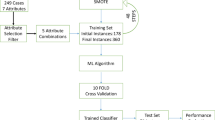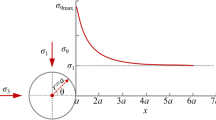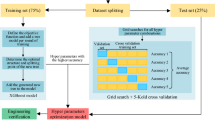Abstract
An unbalanced rockburst dataset will restrict the accuracy and reliability of rockburst prediction based on machine learning. Therefore, a new oversampling algorithm was proposed based on Copula theory and Monte Carlo simulation to balance the dataset. This paper collected 243 rockburst cases worldwide. The predictors of rockburst used in this paper include the maximum tangential stress of the surrounding rock, the uniaxial compressive strength of rock, the tensile strength of rock, and the elastic energy index. During oversampling, Copula theory determined the predictors' joint distribution function by considering the correlation among predictors. Then Monte Carlo simulation was performed to generate enough data for oversampling according to rockburst classification standard. Six common machine learning methods with tenfold cross-validation were adopted to establish nonlinear models between predictors and rockburst grades. The accuracy rate of rockburst prediction has increased by 9.3–15.5% after oversampling. The prediction performance is better than the commonly used synthetic minority oversampling technique. Finally, rockburst predictors' importance was evaluated with the initial dataset, and the elastic energy index got the maximum value of 0.41. The proposed oversampling algorithm in this paper can reasonably overcome class imbalance and improve the prediction performance for rockburst.









Similar content being viewed by others
Abbreviations
- Copula-MC:
-
Copula theory and Monte Carlo simulation
- SMOTE:
-
synthetic minority oversampling technique
- σ θ :
-
the maximum tangential stress of the surrounding rock
- σ c :
-
the unitial compressive strength of rock
- σ t :
-
the tensile strength of rock
- W et :
-
the elastic energy index
- σ θ/σ c :
-
the stress ratio
- σ c/σ t :
-
the rock brittleness ratio
References
Afraei S, Shahriar K, Madani S (2019) Developing intelligent classification models for rock burst prediction after recognizing significant predictor variables, Section 2: Designing classifiers. Tunn Undergr Space Technol 84:522–537. https://doi.org/10.1016/j.tust.2018.11.011
Arias G, Mesiar R, De B (2017) The unwalked path between quasi-copulas and copulas: Stepping stones in higher dimensions. Int J Approximate Reasoning 80:89–99. https://doi.org/10.1016/j.ijar.2016.08.009
Bernardo A, Della V (2021) VFC-SMOTE: very fast continuous synthetic minority oversampling for evolving data streams. Data Min Knowl Disc. https://doi.org/10.1007/s10618-021-00786-0
Breiman L, Friedman J, Olshen R, Stone C (1984) Classification and Regression Trees (CART). Biometrics 40(3):358
Camous L, Melander C, Vallet M, Squalli T, Knebelmann B, Noel L, Fakhouri F (2008) Complete remission of lupus nephritis with rituximab and steroids for induction and rituximab alone for maintenance therapy. Am J Kidney Dis 52(2):346–352
Cao H, Xie X, Wang Y, Deng Y (2021) The interactive natural drivers of global geogenic arsenic contamination of groundwater. J Hydrol 597. https://doi.org/10.1016/j.jhydrol.2021.126214
Chawla N, Bowyer K, Hall L, Kegelmeyer WP (2002) SMOTE: Synthetic minority over-sampling technique. J Artif Intelligence Res 16(1):321–357
Dong L, Li X, Peng K (2013) Prediction of rockburst classification using Random Forest. Transactions of Nonferrous Metals Society of China 23(2):472–477. https://doi.org/10.1016/S1003-6326(13)62487-5
Du Z, Xu M, Liu Z, Wu X (2006) Laboratory integrated evaluation method for engineering wall rock rock-burst. Gold 11:26–30
Faradonbeh R, Taheri A (2019) Long-term prediction of rockburst hazard in deep underground openings using three robust data mining techniques. Engineering with Computers 35(2):659–675. https://doi.org/10.1007/s00366-018-0624-4
Feng X, Chen B, Ming H, Wu S, Xiao Y, Feng G, Zhou H, Qiu S (2012) Evolution law and mechanism of rockbursts in deep tunnels: immediate rockburst. Chin J Rock Mech Eng 31(3):433–444
Feng X, Xiao Y, Feng G, Yao Z, Chen B, Yang C, Su G (2019) Study on the development process of rockbursts. Chin J Rock Mech Eng 38(4):649–673
Feng X, Liu J, Chen B, Xiao Y, Feng G, Zhang F (2017) Monitoring, Warning, and Control of Rockburst in Deep Metal Mines. Engineering 3(4):538–545. https://doi.org/10.1016/J.ENG.2017.04.013
Ghasemi E, Gholizadeh H, Adoko A (2020) Evaluation of rockburst occurrence and intensity in underground structures using decision tree approach. Eng Comput 36(1):213–225. https://doi.org/10.1007/s00366-018-00695-9
Gong F, Li X (2007) A distance discriminant analysis method for prediction of possibility and classification of rockburst and its application. Chin J Rock Mech Eng 26(5):1013–1018
Gong F, Luo S, Jiang Q, Xu L (2022) Theoretical verification of the rationality of strain energy storage index as rockburst criterion based on linear energy storage law. J Rock Mech Geotech Eng. https://doi.org/10.1016/j.jrmge.2021.12.015
He M, Zhao F, Du S, Zheng M (2014) Rockburst characteristics based on experimental tests under different unloading rates. Rock and Soil Mechanics 35(10):2737–2747
Jia Q, Wu L, Li B, Chen C, Peng Y (2019) The Comprehensive Prediction Model of Rockburst Tendency in Tunnel Based on Optimized Unascertained Measure Theory. Geotech Geol Eng 37(4):3399–3411. https://doi.org/10.1007/s10706-019-00854-9
Kaiser P, Cai M (2012) Design of rock support system under rockburst condition. J Rock Mech Geotech Eng 4(3):215–227
Kidybiński A (1981) Bursting liability indices of coal. J Rock Mech Geotech Eng 4(3):215–227. Int J Rock Mech Mining Sci 18(4):295–304. https://doi.org/10.1016/0148-9062(81)91194-3
Kim G, Silvapulle M, Silvapulle P (2007) Comparison of semiparametric and parametric methods for estimating copulas. Comput Stat Data Anal 51(6):2836–2850. https://doi.org/10.1016/j.csda.2006.10.009
Li D, Tang X, Zhou C (2015) Uncertainty characterization and reliability analysis of rock and soil parameters based on copula theory. Science Press, Beijing
Li S, Wang S, Wu L (2017a) Quality classification of rock mass based on MCS-TOPSIS coupling model. Chin J Rock Mech Eng 36(5):1053–1062
Li T, Li Y, Yang X (2017b) Rock burst prediction based on genetic algorithms and extreme learning machine. Journal of Central South University 24(9):2105–2113
Li X, Wang X, Kang Y, He Z (2005) Artificial neural network for prediction of rockburst in deep-buried long tunnel. In: 2nd International Symposium on Neural Networks, 30 May-1 Jun 2005. China, Chongqing
Liang X, Jiang A, Li T, Xue Y, Wang G (2020) LR-SMOTE - An improved unbalanced data set oversampling based on K-means and SVM. Knowl-Based Syst 196. https://doi.org/10.1016/j.knosys.2020.105845
Lin W, Tsai C, Hu Y, Jhang J (2017) Clustering-based undersampling in class-imbalanced data. Inf Sci 409:17–26. https://doi.org/10.1016/j.ins.2017.05.008
Liu R, Ye Y, Hu N, Chen H, Wang X (2019) Classified prediction model of rockburst using rough sets-normal cloud. Neural Comput Appl 31(12):8185–8193. https://doi.org/10.1007/s00521-018-3859-5
Lü T, Tang X, Li D, Qi X (2020) Modeling multivariate distribution of multiple soil parameters using vine copula model. Comput Geotech 118. https://doi.org/10.1016/j.compgeo.2019.103340
Mostajabi A, Finney D, Rubinstein M, Rachidi F (2019) Nowcasting lightning occurrence from commonly available meteorological parameters using machine learning techniques. Npj Climate and Atmospheric Science 2:41. https://doi.org/10.1038/s41612-019-0098-0
Nelsen B (2006) An Introduction to Copulas. Springer, New York
Pu Y, Apel D, Xu H (2019) Rockburst prediction in kimberlite with unsupervised learning method and support vector classifier. Tunn Undergr Space Technol 90:12–18. https://doi.org/10.1016/j.tust.2019.04.019
Qian Q (2014) Definition, mechanism, classification and quantitative forecast model for rockburst and pressure bump. Rock and Soil Mechanics 35(1):1–6
Rastegarmanesh A, Moosavi M, Kalhor A (2021) A data-driven fuzzy model for prediction of rockburst. Georisk: Assessment and Management of Risk for Engineered Systems and Geohazards 15(2):152–164. https://doi.org/10.1080/17499518.2020.1751208
Shi X, Zhou J, Dong L, Hu H, Wang H, Chen S (2010) Application of unascertained measurement model to prediction of classification of rockburst intensity. Chin J Rock Mech Eng 29(S1):2720–2726
Singh S (1987) The influence of rock properties on the occurrence and control of rockbursts. Min Sci Technol 5(1):11–18. https://doi.org/10.1016/S0167-9031(87)90854-1
Sklar A (1959) Fonctions de Répartition à n Dimensions et Leurs Marges. Publications de l’Institut Statistique de l’Université de Paris, Paris
Szecowka Z, Domzal J, Ozana P (1973) Energy index of natural bursting ability of coal. Transactions of the Central Mining Institute, Poland
Tan W, Ye Y, Hu N, Wu M, Huang Z (2021) Severe rock burst prediction based on the combination of LOF and improved SMOTE algorithm. Chin J Rock Mech Eng 40(6):1186–1194
Tang X, Li D, Rong G, Phoon K, Zhou C (2013) Impact of copula selection on geotechnical reliability under incomplete probability information. Comput Geotech 49:264–278. https://doi.org/10.1016/j.compgeo.2012.12.002
Tang Z, Wang X, Xu Q (2021) Rockburst prediction based on oversampling and objective weighting method. Journal of Tsinghua University (science and Technology) 61(6):543–555
Wu S, Wu Z, Zhang C (2019) Rock burst prediction probability model based on case analysis. Tunn Undergr Space Technol 93. https://doi.org/10.1016/j.tust.2019.103069
Xie Z (2010) MATLAB statistical analysis and application: 40 case analysis. Beijing University of Aeronautics and Astronautics Press, Beijing
Xue Y, Bai C, Kong F, Qiu D, Li L, Su M, Zhao Y (2020a) A two-step comprehensive evaluation model for rockburst prediction based on multiple empirical criteria. Eng Geol 268. https://doi.org/10.1016/j.enggeo.2020a.105515
Xue Y, Bai C, Qiu D, Kong F, Li Z (2020b) Predicting rockburst with database using particle swarm optimization and extreme learning machine. Tunn Undergr Space Technol 98. https://doi.org/10.1016/j.tust.2020b.103287
Xue Y, Li Z, Li S, Qiu D, Tao Y, Wang L, Yang W, Zhang K (2019a) Prediction of rock burst in underground caverns based on rough set and extensible comprehensive evaluation. Bull Eng Geol Env 78(1):417–429. https://doi.org/10.1007/s10064-017-1117-1
Xue Y, Li Z, Qiu D, Zhang L, Zhao Y, Zhang X, Zhou B (2019b) Classification model for surrounding rock based on the PCA-ideal point method: an engineering application. Bull Eng Geol Env 78(5):3627–3635. https://doi.org/10.1007/s10064-018-1368-5
Yin X, Liu Q, Huang X, Pan Y (2021a) Real-time prediction of rockburst intensity using an integrated CNN-Adam-BO algorithm based on microseismic data and its engineering application. Tunn Undergr Space Technol 117. https://doi.org/10.1016/j.tust.2021a.104133
Yin X, Liu Q, Pan Y, Huang X, Wu J, Wang X (2021b) Strength of Stacking Technique of Ensemble Learning in Rockburst Prediction with Imbalanced Data: Comparison of Eight Single and Ensemble Models. Nat Resour Res 30(2):1795–1815. https://doi.org/10.1007/s11053-020-09787-0
Yu H, Liu H, Lu X, Liu H (2009) Prediction method of rock burst proneness based on rough set and genetic algorithm. J Coal Sci Eng 15(4):7
Zhou J, Guo H, Koopialipoor M, Jahed A, Tahir M (2020) Investigating the effective parameters on the risk levels of rockburst phenomena by developing a hybrid heuristic algorithm. Engineering with Computers 37(3):1679–1694. https://doi.org/10.1007/s00366-019-00908-9
Zhou J, Li X, Mitri H (2017) A critical survey of empirical methods for evaluating rockburst potential. In: 15th IACMAG, 19–23 October 2017. China, Wuhan
Zhou J, Li X, Mitri H (2016) Classification of Rockburst in Underground Projects: Comparison of Ten Supervised Learning Methods. J Comput Civ Eng 30(5). https://doi.org/10.1061/(ASCE)CP.1943-5487.0000553
Zhou J, Li X, Shi X (2012) Long-term prediction model of rockburst in underground openings using heuristic algorithms and support vector machines. Saf Sci 50(4):629–644. https://doi.org/10.1016/j.ssci.2011.08.065
Zhou X, Huang X, Liu P, Li T (2018) A probabilistic method to analyze collapse failure of shallow rectangular tunnels. Tunn Undergr Space Technol 82:9–19. https://doi.org/10.1016/j.tust.2018.07.029
Acknowledgements
Research in this paper is supported by the National Natural Science Foundations of China (grant numbers 41877239, 51379112, 51422904, 40902084, and 41772298), Fundamental Research Funds of Shandong University (grant number 2018JC044), and Shandong Provincial Natural Science Foundation (grant number JQ201513).
Author information
Authors and Affiliations
Contributions
Yiguo Xue contributed to supervision, project administration, and funding acquisition. Guangkun Li contributed to conceptualization, methodology, writing—original draft, writing—review and editing, software, and investigation. Zhiqiang Li performed data curation. Peng Wang performed validation. Huimin Gong performed investigation. Fanmeng Kong carried out formal analysis.
Corresponding author
Ethics declarations
Competing Interest
The authors declare that they have no conflict of interest.
Supplementary Information
Below is the link to the electronic supplementary material.
Rights and permissions
About this article
Cite this article
Xue, Y., Li, G., Li, Z. et al. Intelligent prediction of rockburst based on Copula-MC oversampling architecture. Bull Eng Geol Environ 81, 209 (2022). https://doi.org/10.1007/s10064-022-02659-2
Received:
Accepted:
Published:
DOI: https://doi.org/10.1007/s10064-022-02659-2




